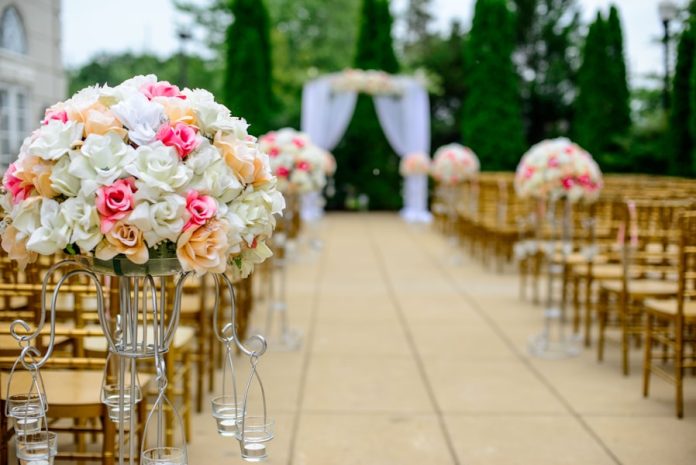
Beautiful arches and sweeping vistas mean little if vows drift into the wind or guests squint against glare. A ceremony setting must carry sound, movement, and comfort as gracefully as it frames photographs. When couples weigh logistics as carefully as florals or attire, a location becomes more than a backdrop—it becomes the stage where words resonate and memories settle deeply.
Walking the site with senses fully alert reveals details that photos cannot: the hush of distant traffic, the wobble of gravel underfoot, or the shifting sun angle at the precise hour. Planning microphone placement, guest paths, restroom proximity, and reset flow in advance turns potential obstacles into invisible support, creating space for emotion and presence.
Sound and Acoustics
An empty aisle at midday shows how sound behaves differently than expected. Pause to hear echoes, traffic hum, wind bursts, or HVAC thrum that could disrupt vows and music. Note hard surfaces that bounce sound, identify drop-off pockets, and discuss solutions early with the AV team.
Ask which gear the venue provides and where speakers can be positioned for even coverage. Test wireless mic range, confirm recorder placement for wedding live bands or solo musicians, and always keep spare batteries and a handheld mic nearby. Running a full-volume rehearsal with officiant, readers, and musicians present reveals hidden issues and locks in a smooth, confident delivery for the ceremony.
Guest Accessibility and Comfort
An elderly guest on loose gravel highlights why arrival paths matter. Walk every route, noting uneven pavers, stairs, or loose stone. Provide firm alternatives with temporary ramps, adequate width for wheelchairs, and subtle lighting along steps. Mark hazards clearly so movement feels secure and stress-free.
Comfort extends to seating and amenities. Group shaded chairs or portable canopies, place armrest seats at aisle ends, and leave space beside reserved spots for walkers or mobility devices. Keep restrooms nearby with clear signage, and add risers or staggered rows for sightlines. Extras like water stations, fans for heat, and stroller parking ease movement, keeping guests attentive and comfortable.
Lighting and Visibility
The late-afternoon glow can flatter faces or throw sharp shadows across vows. Scout the venue at the exact ceremony hour to observe sun angles, glare points, and shifting tree shade. Position the couple at a gentle 45-degree angle to the sun for depth without harsh squinting, and note potential trouble spots for the officiant and photographer.
Evening ceremonies need equal care. Inspect installed fixtures for flicker, test bulb color, and confirm backup power. Ask about dimming flexibility to preserve the atmosphere. Simple tools like scrims or diffusers soften patchy light, while warm backlighting separates subjects for vivid photos. A rehearsal lighting diagram secures settings and avoids guesswork on the day.
Privacy and Surroundings
A passerby on a promenade or a truck at a nearby dock can pull focus from vows instantly. Walk the perimeter at ceremony hour to identify event noise, foot traffic, adjacent patios, and visible balconies. Listen for kitchens, delivery bays, or outdoor speakers that could bleed into the moment.
Mitigation begins with mapping staff entrances and confirming staging areas with the coordinator. Add soft screening—potted greenery, fabric panels, or decorative partitions—to limit visual distractions. Work with management to schedule a short service blackout and request nearby venues pause music briefly. Small measures shield the ceremony, quieting distractions and centering all attention on the couple.
Transition Into the Reception
Guests often stall in the courtyard when the next step isn’t obvious. Trace the route from altar to cocktails to reception, measuring realistic walk times and adding a buffer for stairs or elevators. Use ushers, musician cues, or visual markers to guide the flow, and create clear shortcuts for mobility needs, including stroller-friendly paths for families.
Behind the scenes, assign reset duties to each vendor and confirm truck access and timing. Reuse floral pieces at the reception entrance or head table, and let the final ceremony song signal cocktail hour. A color-coded run sheet with vendor contacts keeps transitions seamless. Planning walk time plus buffer maintains steady, welcoming momentum without confusion.
A ceremony setting is more than a scenic backdrop. Test audio at real volume, secure windscreens, and place speakers thoughtfully. Provide shaded, stable paths with nearby restrooms and accessible seating. Visit at the exact hour to study light and adjust staging for clear photographs. Coordinate staff staging areas, resets, and a logical guest flow into reception spaces. Thoughtful fixes sharpen sound, streamline timing, and enhance comfort, letting promises take center stage. Treat logistics as hospitality: anticipate needs, reduce friction, and support presence. Guests remember warmth, clarity, and ease long after flowers fade and music ends.

